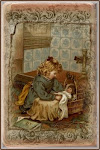 TIE DYED EASTER EGGS
TIE DYED EASTER EGGSWant an easy, fun way to decorate your Easter eggs this year?
SUPPLIES:
Eggs, hard-boiled, boiled in a saucepan of water with 1 tbsp of vinegar added
or blown eggs
food coloring in assorted colors
paper towels
plastic wrap
old shirt or apron
INSTRUCTIONS:
This is such an easy way to make tie dyed Easter eggs - and very pretty too.
Boil your eggs or blow the eggs out if you wish to keep them permanently.
To blow out an egg:
Poke a small hole in each end of the egg. Use a long needle or skewer to break the yoke. Hold the egg over a bowl and blow hard through one hole until the egg has emptied out of the shell. Rinse with water, let dry, and decorate.
To Tie Die Eggs:
Take a paper towel and dampen the towel with water and vinegar, making sure it is just damp.
Place a piece of plastic wrap under the paper towel.
Drip small drops of food coloring onto the paper towel. Allow colors to drop next to each other so they bleed slightly together. Make sure there is enough area with food color to cover egg.
Wrap an egg in the paper towel and the plastic wrap. The longer you keep the egg in the brighter the egg will get.
Repeat until all your eggs are tie dyed. Every one will be different, but all of them will be pretty.
By Twila Lenoir
 NATURALLY DYED EASTER EGGS
NATURALLY DYED EASTER EGGSThe most beautiful dyes for Easter eggs come from foodstuff you probably already have in your kitchen. The colors are very unusual -- gentle, earthy, soft, and very vibrant, without being harsh like the artificial dyes.
To color these eggs, you boil the eggs with the dyestuff, rather than boiling the eggs separately and then dying them.
DIRECTIONS:
Put raw, white-shelled, organically-raised eggs in a single layer in a pan. Cover with cold water. Add a little more than a teaspoon of white vinegar. Add the natural dyestuff for the color you want your eggs to be. (The more eggs you are dying at a time, the more dye you will need to use, and the more dye you use, the darker the color will be.)
Bring water to a boil, then reduce heat and simmer for 15 minutes.
Quickly check the eggs for color by removing them from the dye liquid with a slotted spoon.
If the color is as desired, pour off the hot dye liquid and rinse the eggs immediately in cold water to stop the eggs from cooking. Continue to change the water until it stays cool in the pot because the eggs are no longer releasing heat. Drain and allow eggs to cool in the refrigerator.
If you wish a deeper color, strain the hot dye liquid into a container, then rinse the eggs immediately in cold water to stop them from cooking. Continue to change the water until it stays cool in the pot because the eggs are no longer releasing heat. Drain the last of the cold water, then cover the eggs with the strained dye liquid. Add more water if necessary so that the eggs are completely covered. Put into the refrigerator immediately and keep eggs in the refrigerator until the desired shade is achieved. Overnight is good. Longer than about twelve hours some of the colors just get muddier instead of deeper, and the lighter shades are more vibrant.
Try these foods to dye your eggs:
Red - Pink -- lots of red onion skins, cranberry juice, or frozen raspberries.
Orange -- Yellow onion skins
Brown -- Red beet skins or grape juice (produces a beautiful sparkling tan), coffee.
Yellow -- Saffron, tumeric or cumin, orange or lemon peels, or celery seed.
Green -- spinach, or carrot tops and peels from Yellow Delicious apples for a yellow-green.
Blue -- Red cabbage leaves make the most incredible robin's-egg blue.
Deep Purple -- Red wine makes a beautiful burgundy color
Tips for successful results:
Use filtered or distilled water. Chlorine and other chemicals will work against the dye, making it less intense. Buy distilled water or use your own filtered water.
For deeper colors, use more dyestuff or let the eggs soak longer. For even coverage, cook eggs in a pot large enough to hold enough water and dyestuff to completely cover the eggs, even after some of the liquid has evaporated during the 15 minute of boiling.
Again, for even coverage, if you continue to soak the eggs in the refrigerator after cooking, make sure the eggs are completely covered with the dye liquid. Blot the eggs dry or allow them to air dry, as for some colors the dye will rub off while still wet. On the other hand, if you wish to make a white pattern on the egg, you can rub off some of the dye for some colors immediately after cooking.
Make sure eggs of different colors are completely dry before piling them up in a bowl together, as wet dye from one egg can transfer to another.
By Debra Lynn Dadd
 SPECKLED EASTER EGGS
SPECKLED EASTER EGGSThis method of decorating Easter eggs is very messy - but lots of fun! Just to be sure to wear an apron and spread lots of newspaper around your work surface to catch the flying paint.
SUPPLIES:
hard boiled eggs
egg dye
tempra, watercolor or craft paint or food coloring
old toothbrush
Speckled Eggs
INSTRUCTIONS:
If you want to begin with colored eggs, then dye the eggs using commercial egg dye or natural egg dye.
Spread newspaper over your work surface. It's also a good idea to protect the front of your clothes with an apron or smock.
Dip the toothbrush in a small amount of paint or dye in a contrasting color.
Run your finger or thumb over the top of the toothbrush bristles to splatter the eggs with small drops of color.
Variations: You can wash the toothbrush and use a second or third color to make speckled eggs with lots of different colors.
by Jane Lake
For more crafts like these check out All Free Crafts










.jpg)






































































.jpg)


























.JPG)















3 comments:
WOW!! These eggs turned out so awesome Sue!
I love all your posts... I sooo look forward to reading them . Thanks so much!
I want to thank you for this because I actually did this last Easter and I like the results.
hope chests
where are you? You have not posted in quite awhile. I hope everything is okay.
Post a Comment